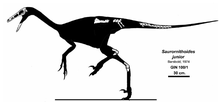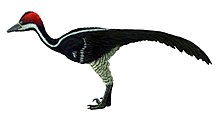Zanabazar junior
| Zanabazar junior Temporal range: Late Cretaceous,
~ | |
|---|---|

| |
| Skeletal restoration of IGM 100/1 | |
| Scientific classification | |
| Domain: | Eukaryota |
| Kingdom: | Animalia |
| Phylum: | Chordata |
| Clade: | Dinosauria |
| Clade: | Saurischia |
| Clade: | Theropoda |
| Family: | †Troodontidae |
| Subfamily: | †Troodontinae |
| Genus: | †Zanabazar Norell et al., 2009 |
| Species: | †Z. junior
|
| Binomial name | |
| †Zanabazar junior | |
| Synonyms | |
| |
Zanabazar is a genus of large troodontid dinosaurs from the Late Cretaceous of Mongolia. The genus was originally named by Rinchen Barsbold as the new species Saurornithoides junior. In 2009 it was reclassified as its own genus and species, Zanabazar junior, named after Zanabazar, the first spiritual figurehead of Tibetan Buddhism in Mongolia.[1] The holotype includes a skull, vertebrae, and right hindlimb. Zanabazar was one of the largest and most derived troodontids.
History of discovery
[edit]
The holotype was discovered in 1964 from the Bügiin Tsav locality of the Nemegt Formation and initially described by Rinchen Barsbold as a new species of Saurornithoides (S. junior) in 1974. This specimen, IGM 100/1, includes a nearly complete skull and braincase, part of the pelvis, some tail vertebrae, and parts of the right hindlimb.[2] In 2009 a review of the genus found that the support for S. junior in the same genus as S. mongoliensis was lacking. Mark Norell and colleagues re-classified the species in the new genus Zanabazar, which they named in honor of Zanabazar, the first spiritual head (Bogd Gegen) of Tibetan Buddhism in Outer Mongolia.[1]
Description
[edit]
Zanabazar were large troodontids reaching 2.3 m (7.5 ft) in length and weighing 25 kg (55 lb).[3] They are the largest known Asian troodontids, with a skull length of 27.2 cm (272 mm). At the time of the discovery of the genus, the only other troodontids that appeared to be larger than it were specimens from Alaska,[1] however, Latenivenatrix are now considered the largest troodontids with 3.5 m (11 ft) in length.[4] The preserved vertebrae in IGM 100/1 are completely fused, indicating that this individual was an adult at the time of death.[1]
Classification
[edit]While originally included in Saurornithoides, within the family Saurornithoididae,[2] Zanabazar is now thought to be a derived member of Troodontidae.[1]


The cladogram below shows the phylogenetic position of Zanabazar among other troodontids following a 2014 analysis.[5]
See also
[edit]References
[edit]- ^ a b c d e Norell, M. A.; Makovicky, P. J.; Bever, G. S.; Balanoff, A. M.; Clark, J. M.; Barsbold, R.; Rowe, T. (2009). "A review of the Mongolian Cretaceous dinosaur Saurornithoides (Troodontidae, Theropoda)". American Museum Novitates (3654): 1−63. doi:10.1206/648.1. hdl:2246/5973.
- ^ a b Barsbold, R. (1974). "Saurornithoididae, a new family of small theropod dinosaurs from Central Asia and North America" (PDF). Palaeontologica Polonica. 30: 5−22.
- ^ Paul, G. S. (2016). The Princeton Field Guide to Dinosaurs (2nd ed.). Princeton, New Jersey: Princeton University Press. p. 161. ISBN 9780691167664.
- ^ van der Reest, A. J.; Currie, P. J. (2017). "Troodontids (Theropoda) from the Dinosaur Park Formation, Alberta, with a description of a unique new taxon: implications for deinonychosaur diversity in North America". Canadian Journal of Earth Sciences. 54 (9): 919−935. Bibcode:2017CaJES..54..919V. doi:10.1139/cjes-2017-0031. hdl:1807/78296. ISSN 0008-4077.
- ^ Tsuihiji, T.; Barsbold, R.; Watabe, M.; Tsogtbaatar, K.; Chinzorig, T.; Fujiyama, Y.; Suzuki, S. (2014). "An exquisitely preserved troodontid theropod with new information on the palatal structure from the Upper Cretaceous of Mongolia". Naturwissenschaften. 101 (2): 131−142. Bibcode:2014NW....101..131T. doi:10.1007/s00114-014-1143-9. PMID 24441791.

